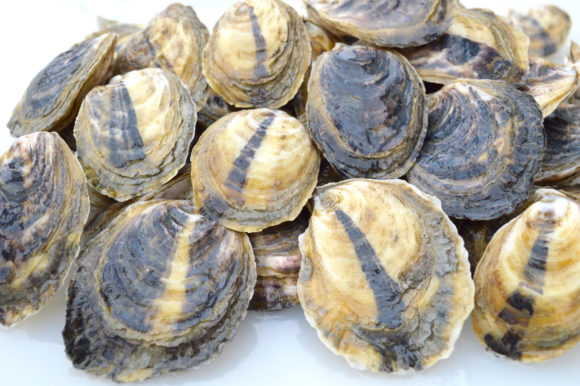A dozen East Coast universities and federal science groups have been awarded a five-year, $4.4 million contract by NOAA to advance selective breeding of oysters for aquaculture.
The Eastern Oyster Breeding Consortium is led by longtime colleagues and collaborators Stan Allen of the Virginia Institute of Marine Sciences and Ximing Guo of Rutgers University, who in 1994 made a first breakthrough with breeding tetraploid oysters, a building block for today’s aquaculture industry.
Research at the Rutgers Haskins Shellfish Laboratory and the VIMS Aquaculture Breeding and Technology Center used traditional breeding techniques to develop strains of Eastern oysters that are now quite resistant to MSX, a parasitic disease that for decades depressed oysters harvests.

Ximing Guo of the Rutgers University Haskins Shellfish Laboratory. Rutgers photo.
In pockets where old oyster beds survived, MSX tended to weaken and kill new shellfish within a couple of years. The development of resistant strains enabled a modest revival that today has grown to a $90 million aquaculture industry, with a growing economic impact from the Carolinas to Maine.
The project is funded by NOAA Fisheries through the Atlantic States Marine Fisheries Commission. Fourteen shellfish geneticists will build on decades of traditional breeding using new techniques, developed from the successful 2012 sequencing of the Eastern oyster genome .
That potentially gives researchers a roadmap for making direct links between the genetic code and specific traits in adult shellfish. They will be looking at a type of variation in oyster DNA, called a single nucleotide polymorphism (SNP) that is the type most frequently occurring in the genome a variation at a single site in DNA, is the most frequent type of variation in the genome.
Disease resistance remains the number-one priority for breeding oysters, but the ambition of the project is to breed for other desirable traits – and potentially tailor those to specific oyster-growing regions.

Stan Allen heads the Virginia Institute of Marine Sciences Aquaculture Breeding and Technology Center. VIMS photo.
In their natural range from the Gulf of Mexico to Maine, oysters grow under a wide variety of environmental conditions. The consortium could develop breeds that grow faster and fatter under those conditions – and offer improved hardiness under difficult circumstances, such as bouts of low-oxygen hypoxia that afflict Chesapeake Bay in summer months.
If the team can identify the genetic markers associated with those traits, shellfish breeders would be able to select specific brood stock to carry those genes for improved performance.
Along with VIMS and Rutgers, the consortium includes contributors based at the University of Rhode Island, the University of Maryland Center for Environmental Science, Northeastern University Marine Science Center, Stony Brook University, University of Maine, Cornell University, Morgan State University, University of North Carolina at Wilmington, NOAA’s Northeast Fisheries Science Center and the U.S. Department of Agriculture’s Agricultural Research Service. Their work is also being supported by the East Coast Shellfish Growers Association.







